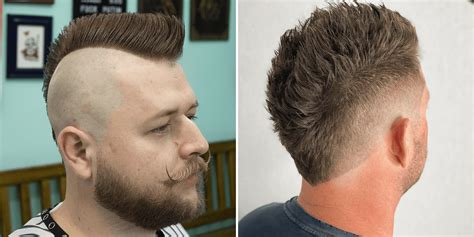Introduction
In the realm of hairstyles, the faux hawk and mohawk reign supreme as two of the most iconic and edgy looks. Both styles share a rebellious spirit and a penchant for defying convention, but they also possess unique characteristics that set them apart. In this comprehensive comparison, we delve into the intricate details of faux hawks and mohawks, exploring their origins, benefits, variations, and which one is the perfect choice for your style.

Origins and History
Faux Hawk (Fohawk)
Emerging in the late 2000s, the faux hawk is a modern take on the classic mohawk. Its roots can be traced back to athletes and rock stars who desired the edgy look of a mohawk without the commitment of shaving the sides. The faux hawk offers a compromise, creating the illusion of a mohawk without the need for a major hair alteration.
Mohawk (Mohican)
The mohawk has a far more ancient lineage, dating back to Native American tribes. For many tribes, including the Mohawk nation, the mohawk hairstyle held cultural and religious significance. It was believed to represent strength, bravery, and a connection to the spiritual realm. In modern times, the mohawk has transcended its cultural origins and become a symbol of rebellion, individuality, and nonconformity.
Appearance and Characteristics
Faux Hawk
- Characterized by a longer strip of hair in the center of the head, shaved or closely trimmed on the sides.
- The center strip can be styled in various ways, including spikes, gelled back, or messy.
- Can be styled on any hair texture, including straight, curly, or wavy.
- Versatile, suitable for both casual and formal occasions.
Mohawk
- Defined by a narrow ridge of long hair running down the center of the head.
- Sides are shaved to create a stark contrast.
- Can vary in height, from a few inches to several feet.
- Often associated with punk or heavy metal subcultures.
Benefits and Drawbacks
Faux Hawk
-
Benefits:
- Edgy, stylish look
- Versatile styling options
- Less maintenance compared to a mohawk
- Suitable for a wide range of hair types
-
Drawbacks:
- Can appear less dramatic than a mohawk
- May not be appropriate for all work environments
Mohawk
-
Benefits:
- Bold, eye-catching statement
- Symbol of individuality and rebellion
- Can be customized with various hair colors or patterns
- May conceal thinning hair on the sides
-
Drawbacks:
- Requires regular trimming to maintain shape
- Can be impractical for certain activities or professions
- May require more styling effort than a faux hawk
Variations and Styles
Faux Hawk
- Electric Faux Hawk: Spikes the hair in the center strip, creating a bold and dramatic look.
- Slicked Back Faux Hawk: Gels the hair in the center strip back, resulting in a sleek and sophisticated appearance.
- Messy Faux Hawk: Leaves the hair in the center strip unstyled, creating a textured and carefree look.
Mohawk
- Liberty Spike Mohawk: Elongates the hair in the center strip, creating a single large spike.
- Fanned Mohawk: Spikes the hair in the center strip outwards, creating a wide and dramatic effect.
- Braided Mohawk: Incorporates braids into the center strip, adding complexity and visual interest.
Which Style is Right for You?
The ultimate choice between a faux hawk and mohawk depends on your individual style, lifestyle, and preferences. Consider the following factors when making your decision:
- Level of Commitment: A faux hawk requires less commitment and can be easily styled back into a more traditional look.
- Personality: A mohawk is a bolder statement, suitable for those who want to express their individuality.
- Hair Type: Some hair textures may be better suited for one style over the other.
- Occupation: Certain work environments may have stricter grooming policies that restrict the wearing of mohawks.
Tips and Tricks
- Styling a Faux Hawk: Use styling gel or mousse to shape the center strip. Experiment with different combs or brushes to create various textures.
- Styling a Mohawk: Use hairspray to hold the mohawk in place. For a more dramatic effect, add hair extensions.
- Maintenance: Trim the sides of your mohawk every 3-4 weeks to maintain the shape. Wash the center strip regularly to prevent oil buildup.
- Transitioning Between Styles: If you’re moving from a mohawk to a faux hawk, gradually grow out the sides. Use a headband or hair clips to hold back the hair while it grows.
Step-by-Step Guide
Faux Hawk
- Wash and towel dry your hair.
- Apply styling gel or mousse to the center strip.
- Use a comb or brush to style the hair upwards.
- Finish with hairspray to hold the style in place.
Mohawk
- Shave or closely trim the sides of your hair.
- Wash and towel dry the center strip.
- Apply styling gel to the center strip.
- Use a comb or brush to style the hair upwards.
- Secure the mohawk with hairspray.
Conclusion
Whether you opt for the bolder statement of a mohawk or the versatility of a faux hawk, both styles offer a unique way to express your personality and defy conventions. By understanding the origins, characteristics, and variations of these hairstyles, you can make an informed decision that suits your individual needs and aspirations. Embrace the spirit of rebellion and rock your chosen style with confidence.
